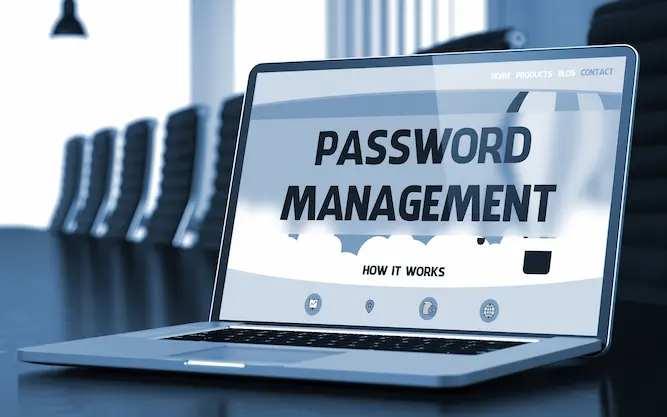Get us to call you
Fill in your details below to receive a call back quickly.
Fill in your details below to receive a call back quickly.
Fill in your details below to receive a call back quickly.
Fill in your details below to receive a call back quickly.

In today’s interconnected world, where cyber threats are becoming increasingly sophisticated, strong password management is a critical aspect of maintaining digital security. As a team leader or manager, it is essential to implement best practices for password management to protect sensitive data and ensure the integrity of your team’s online accounts. In this blog post, we will delve into the key strategies and guidelines that can help your team establish robust password management practices, reducing the risk of data breaches and unauthorized access.

or fill in our online enquiry form today to contact us.
1. Password Complexity and Strength
One of the fundamental aspects of password management is creating complex and strong passwords. Encourage your team members to follow these guidelines:
a) Length: Opt for passwords with a minimum of 12 characters, as longer passwords are harder to crack.
b) Complexity: Utilize a combination of uppercase and lowercase letters, numbers, and special characters. Avoid common patterns or predictable sequences.
c) Avoid Personal Information: Discourage the use of easily guessable details like names, birthdays, or phone numbers.
d) Unique for Each Account: Emphasize the importance of using distinct passwords for different accounts. Reusing passwords increases the vulnerability of multiple accounts in case of a breach.
2. Password Management Tools
Encourage your team to utilise password management tools to simplify and strengthen their password practices. These tools generate and securely store complex passwords, offering the following benefits:
a) Password Encryption: Password managers employ advanced encryption techniques to secure passwords, reducing the risk of unauthorized access.
b) Convenience and Efficiency: These tools remember and auto-fill passwords, eliminating the need to memorize complex strings of characters for each account.
c) Cross-Platform Accessibility: Password managers are compatible with various devices and operating systems, ensuring access to passwords whenever needed.
d) Two-Factor Authentication (2FA): Some password management tools also provide 2FA options, adding an extra layer of security to accounts.
Everything from IT Advice to Microsoft 365 to VoIP business systems
Call our Team of IT Experts Today on 9111 1740

or fill in our online enquiry form today to contact us.
Regular Password Updates
Encourage your team to update their passwords regularly. While it may seem burdensome, this practice is crucial for mitigating risks associated with data breaches or leaks. Suggest the following strategies:
a) Time-Based Updates: Recommend changing passwords every 90 days or as per the organization’s policy.
b) Notifications and Reminders: Set up automated reminders to prompt team members to update their passwords regularly.
c) Education and Awareness: Highlight the importance of regular updates and explain the rationale behind this practice to ensure buy-in from your team.
Two-Factor Authentication (2FA) or MultiFactor Authentication (MFA)
Implementing two-factor authentication (2FA) or Multifactor Authentication (MFA) adds an additional layer of security to team accounts. 2FA requires users to provide two forms of identification before accessing an account, usually a password and a temporary code sent to a trusted device such as your mobile phone or a RSA key. Essentially 2FA make the password redundant. As the 2nd factor changes regularly the login details are always changing making it much harder to malicious actors to access your accounts. Encourage your team to enable 2FA whenever possible, as it:
a) Strengthens Security: Even if a password is compromised, unauthorized access is still prevented due to the need for an additional verification step.
b) Protects Against Phishing Attacks: 2FA makes it difficult for attackers to gain access, even if they trick someone into revealing their password.
c) Widely Supported: Many online platforms and services offer 2FA as an option, making it easy for team members to enable and use.
d) Biometric Authentication: Utilizing biometrics like fingerprints or facial recognition as an additional authentication method can further enhance security.
The good news is Microsoft 365 includes MultiFactor Authentication for all levels of licenses. If you have a Microsoft 365 account, you should turn your Multifactor. If you need help doing this please call our expert team to setup MFA for you.
Effective password management is a vital component of safeguarding your team’s digital security. By adhering to best practices such as creating strong passwords, employing password management tools, regularly updating passwords, and implementing two-factor authentication, you can significantly reduce the risk of unauthorized access and data breaches. As a team leader, it is essential to promote awareness, provide training, and establish policies that encourage secure password practices. By prioritizing password management, you can empower your team to protect sensitive information, ensuring a safer digital environment for everyone involved.
Securing your business’s passwords aligns closely with the Australian Signals Directorate’s (ASD) Essential Eight, a set of cybersecurity strategies designed to mitigate cyber threats. By implementing best practices for password management, your business can address several Essential Eight recommendations to enhance its overall cybersecurity resilience.
1. Application Whitelisting:
Password management tools can be considered trusted applications and included in your application whitelist. By allowing only approved and verified applications to run, you reduce the risk of malicious software infiltrating your systems, enhancing overall security.
2. Patch Applications:
Password management tools should be regularly updated to the latest versions to address potential security vulnerabilities. Keeping these tools up-to-date aligns with the Essential Eight’s recommendation of patching applications to safeguard against known exploits.
3. Restrict Administrative Privileges:
With password management tools, your employees won’t need administrative privileges to manage passwords manually. By reducing administrative access, your business can prevent unauthorized changes to critical systems and limit the impact of potential breaches.
4. Multi-Factor Authentication (MFA):
Password management tools often offer built-in support for multi-factor authentication (MFA). This aligns with the Essential Eight’s recommendation to implement MFA as an additional layer of security to protect against unauthorized access.
5. Daily Backups:
While password management tools securely store passwords, it’s still essential to perform regular backups to ensure no data is lost. By adhering to proper backup practices, your business can recover from incidents like data loss due to accidental deletion or a compromised password manager.
6. User Application Hardening:
Educating your employees on password management best practices and implementing tools that enforce strong password policies contribute to user application hardening. This ensures that your team remains vigilant against potential security threats.
7. Incident Response Planning:
Incorporating password management into your incident response plan is crucial. In the event of a breach or data leak, prompt action and secure password management practices can help contain the situation and prevent further damage.
8. User Education and Awareness:
Promoting the importance of password management best practices aligns with the Essential Eight’s focus on user education and awareness. By educating your team on creating strong passwords, enabling 2FA, and using password management tools, you empower them to be an active line of defense against cyber threats.
Everything from IT Advice to Microsoft 365 to VoIP business systems
Call our Team of IT Experts Today on 9111 1740
